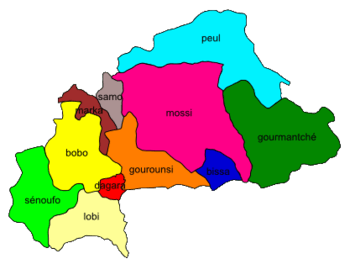Music of Burkina Faso

The music of Burkina Faso includes the folk music of 60 different ethnic groups. The Mossi people, centrally located around the capital, Ouagadougou, account for 40% of the population while, to the south, Gurunsi, Gurma, Dagaaba and Lobi populations, speaking Gur languages closely related to the Mossi language, extend into the coastal states. In the north and east the Fulani of the Sahel preponderate, while in the south and west the Mande languages are common; Samo, Bissa, Bobo, Senufo and Marka. Burkinabé traditional music has continued to thrive and musical output remains quite diverse. Popular music is mostly in French: Burkina Faso has yet to produce a major pan-African success.
National music
The national anthem of Burkina Faso, "Une Seule Nuit", written by Thomas Sankara, has been the official anthem of the country since 1984, when Upper Volta became known as Burkina Faso, even after Sankara was murdered in a coup. Sankara, a guitarist himself, had played in Tout-à-Coup Jazz during the 1970s.
The National Museum of Music in Ouagadougou began its collection in 1998 and has several hundred musical instruments including balafons and bara drums.
The Semaine Nationale de la Culture, held every two years since 1983, is a music festival that has helped produce popular music stars.
Popular music

Burkina Faso has no one popular national style, and many popular recordings are imported from Europe, the United States and Democratic Republic of the Congo. In spite of this influx of popular styles, a few home-grown talents have emerged such as Koudbi Koala's Saaba, who perform traditional Mossi music from the region around Ouagadougou, the nation's capital. Bobo Dioulasso, Burkina Faso's second-largest city, is a cultural centre of Burkina Faso's Mande people of the southwest.
Popular traditional groups from Burkina Faso include balafon bands, percussion ensembles and others such as Farafina and Gabin Dabiré, who uses elements of traditional Burkinabé music.[1]
Traditional music
| Part of a series on the |
| Culture of Burkina Faso |
|---|
 |
| History |
| People |
| Languages |
| Cuisine |
| Religion |
| Art |
| Literature |
|
Music and performing arts |
|
Media |
| Sport |
|
Symbols |
|
The Djeli, a caste of courtly praise-singers in Burkina Faso, function like the griots elsewhere in West Africa: at each ruler's funeral they recite the names and histories of past rulers, they intervene in people's personal affairs and perform at social gatherings. The Mossi and their griots retain ancient royal courts and courtly music.
The kora, the stringed instrument of the djeli, has been popular throughout much of West Africa since the Malian empire of the 1240s. The instrument traditionally featured seven strings until the Gambian griot Madi Woulendi increased that number to twenty-one. The kora can be played in several scales including the hypolydian mode (saouta), silaba, sim'bi and mandéka.
Mande-speakers are also known for the balafon, a kind of wooden xylophone, the exact characteristics of which can vary depending on the maker. The Dagara, Bwa and Senufo peoples also have their own varieties.
Djembe drums, like balafons, are often manufactured in Bobo Dioulasso. The djembe, a vital part of Burkinabé traditional music, is said to be of Malinké origin. It is made from a single piece of wood, usually from a caïlcedrat or lenke tree.
The bendré drum (called bara in Mali and dumaa among the Hausa) is a membranophone made from a gourd with the top cut off and covered with goat or sheep skin. It is an ancient instrument, probably introduced during the reign of Naaba Oubri to be played in sacred music at the royal courts of Moaga by a head drummer (benaaba) who strikes the center or edges of the drum to make varying sounds.
Another stringed instrument is called the n'goni. Legend says it was invented by a Senufo hunter. The n'goni is also played in Niger, Senegal and Mali.
The Fula people (Fulbe) of the north play a variety of traditional instruments including drums, hoddu (or xalam, a plucked skin-covered lute related to the banjo) the and riti or riiti (a one-string bowed instrument), and use complex vocal techniques with clapping percussion. Their griots are known as gawlo.
References
- Bensignor, François. "Hidden Treasure". 2000. In Broughton, Simon and Ellingham, Mark with McConnachie, James and Duane, Orla (Ed.), World Music, Vol. 1: Africa, Europe and the Middle East, pp 437–439. Rough Guides Ltd, Penguin Books. ISBN 1-85828-636-0
- ↑ "Music of Burkina Faso". Frank Bessem's Musiques d'Afrique. Archived from the original on 2005-04-06. Retrieved 15 December 2005.
External links
- (French) Audio clips: Traditional music of Burkina Faso. Musée d'Ethnographie de Genève. Accessed November 25, 2010.
- Audio clip: Balafon. Burkina Faso Cultural Heritage Branch. Accessed November 25, 2010.
- Audio clip: Djembe. Burkina Faso Cultural Heritage Branch. Accessed November 25, 2010.
- Audio clip: Bendré. Burkina Faso Cultural Heritage Branch. Accessed November 25, 2010.
- Audio clip: Kora. Burkina Faso Cultural Heritage Branch. Accessed November 25, 2010.
- Audio clip: N'goni. Burkina Faso Cultural Heritage Branch. Accessed November 25, 2010.
Two current CDs of traditional Burkinabe music are available through Nonesuch Records: 1. Savannah Rhythms and 2. Music of the Grasslands
Documentary films of traditional Burkinabe musicians and celebrations have been published by African Family Films.
| ||||||||||||||
| |||||||||||||||||||||||||||||||||||||||||